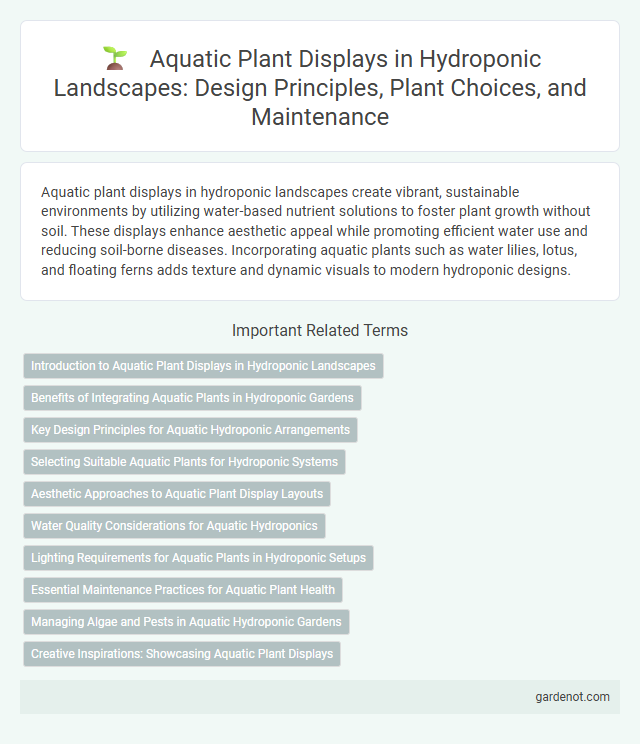Aquatic plant displays in hydroponic landscapes create vibrant, sustainable environments by utilizing water-based nutrient solutions to foster plant growth without soil. These displays enhance aesthetic appeal while promoting efficient water use and reducing soil-borne diseases. Incorporating aquatic plants such as water lilies, lotus, and floating ferns adds texture and dynamic visuals to modern hydroponic designs.
Introduction to Aquatic Plant Displays in Hydroponic Landscapes
Aquatic plant displays in hydroponic landscapes create vibrant, self-sustaining ecosystems by utilizing nutrient-rich water solutions instead of soil. These setups optimize water efficiency and promote rapid plant growth, showcasing species like water lilies, duckweed, and anacharis. Integrating aquatic plants enhances biodiversity, improves water quality, and adds aesthetic appeal to modern landscape designs.
Benefits of Integrating Aquatic Plants in Hydroponic Gardens
Integrating aquatic plants in hydroponic gardens enhances water purification by naturally filtering toxins and maintaining nutrient balance, promoting healthier plant growth. These plants increase oxygen levels in the system, which improves root respiration and overall system productivity. Furthermore, aquatic plants contribute to aesthetic appeal and biodiversity, creating a balanced micro-ecosystem that supports beneficial microorganisms and pest control.
Key Design Principles for Aquatic Hydroponic Arrangements
Key design principles for aquatic hydroponic arrangements include selecting suitable plant species with varying textures and heights to create visual interest and balance. Implementing a well-planned water circulation system ensures optimal oxygenation and nutrient distribution for plant health. Incorporating natural elements like stones and driftwood enhances aesthetics while providing structural support and habitat for beneficial microorganisms.
Selecting Suitable Aquatic Plants for Hydroponic Systems
Selecting suitable aquatic plants for hydroponic systems involves prioritizing species that thrive in water-based environments with minimal soil, such as water lilies, duckweed, and anacharis. These plants require stable nutrient solutions, appropriate pH levels ranging from 6.0 to 7.5, and sufficient light exposure between 8 to 12 hours daily to optimize growth. Incorporating low-maintenance aquatic plants improves system efficiency and enhances the overall aesthetic of hydroponic landscapes.
Aesthetic Approaches to Aquatic Plant Display Layouts
Strategic arrangement of aquatic plants in hydroponic landscapes enhances visual appeal through varied textures, heights, and colors that mimic natural aquatic environments. Utilizing tiered placement and complementary plant groupings creates dynamic focal points, promoting depth and movement within the display. Incorporating floating plants alongside submerged and emergent species balances structural diversity, optimizing both aesthetics and plant health in controlled hydroponic systems.
Water Quality Considerations for Aquatic Hydroponics
Maintaining optimal water quality in aquatic hydroponics is essential to support healthy aquatic plant growth and prevent algae overgrowth. Key parameters such as pH levels between 5.5 and 7.0, dissolved oxygen above 6 mg/L, and low concentrations of ammonia and nitrates must be constantly monitored and adjusted. Using filtration systems and regular water changes enhances nutrient balance and prevents toxins from accumulating, ensuring a vibrant aquatic plant display.
Lighting Requirements for Aquatic Plants in Hydroponic Setups
Aquatic plants in hydroponic setups require specific lighting conditions to thrive, typically needing 10 to 12 hours of full-spectrum light per day to support photosynthesis and healthy growth. LED grow lights are preferred due to their energy efficiency and ability to provide the optimal light spectrum, including blue and red wavelengths essential for plant development. Maintaining consistent light intensity between 30 to 50 micromoles per square meter per second (mmol/m2/s) ensures vibrant aquatic plant growth and prevents algae overgrowth in hydroponic landscapes.
Essential Maintenance Practices for Aquatic Plant Health
Maintaining optimal water quality through regular monitoring of pH, temperature, and nutrient levels is crucial for the health of aquatic plants in hydroponic landscapes. Consistent removal of algae and debris prevents disease and ensures light penetration, promoting photosynthesis and growth. Periodic pruning and checking for pests support vigorous development and prevent overcrowding in aquatic plant displays.
Managing Algae and Pests in Aquatic Hydroponic Gardens
Effective management of algae and pests in aquatic hydroponic gardens requires maintaining optimal water circulation and nutrient balance to prevent algae overgrowth. Introducing beneficial organisms such as snails or fish can naturally control pest populations while preserving plant health. Regular monitoring and timely interventions with eco-friendly treatments ensure a balanced aquatic ecosystem that supports vibrant plant displays.
Creative Inspirations: Showcasing Aquatic Plant Displays
Aquatic plant displays in hydroponic landscapes transform spaces into vibrant ecosystems by combining submerged and emergent plants in visually striking arrangements. Utilizing clear containers and layered substrates highlights root structures and water movement, inspiring creative compositions that mimic natural habitats. Innovative lighting techniques and temperature control further enhance the aesthetic appeal and health of aquatic plants, fostering dynamic and sustainable designs.
Aquatic plant display Infographic

 gardenot.com
gardenot.com